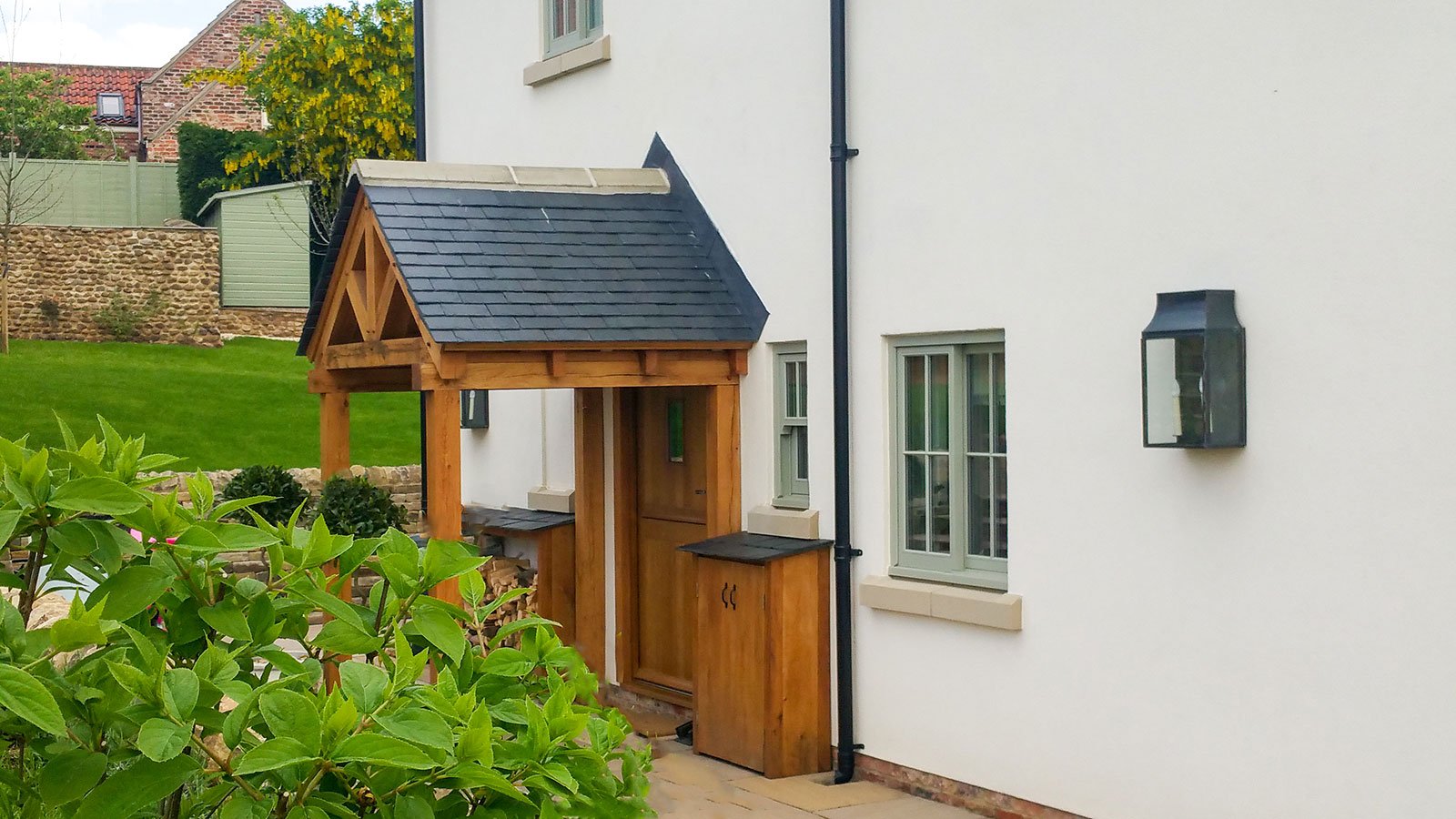
oakbydesign
01423 593 794


Oak By Design recently completed an oak garden room and outdoor kitchen, amongst other internal oak work, for a client (Anna-May James) in Harrogate.
This property features in Oak by Design’s case study section under 'Buildings'.
As the impressive project neared completion, Anna-May chose to have an oak stable door and frame, incorporating a small glazed window, fit to the utility entrance area of their home.
She decided a porch would enhance the door and provide protection and a storage area for the usual paraphernalia – wellies, logs etc!
Anna-May and her husband, Steve, decided to have a completely open porch to allow access from the sides as well as the front. The porch posts sit directly onto the stone flags, which run around the outside of the rendered, contemporary property. The oak posts are slightly raised with stainless steel rods to reduce the risk of the oak sitting in any standing rainwater.
They chose a truss with a king post and diagonal braces but chose not to have curved brackets to the face. Overall this gives a more contemporary appearance to the porch.
The oak porch adds shelter and storage to this area at the back of the house that leads into the butler’s pantry, large utility area and study.
To finish off this utility area of the property, Oak By Design made the client a bespoke boot storage cupboard and a log storage stand, both of which fit against the outside of the house.
The client chose to have the optional fascia boards to the top of the truss and chose to keep the oak pegs proud where the mortise and tenon joints are on the truss.
The oak was all finished with an Osmo Polyx Oil
The large, potted bay trees finish off the welcoming look to the outside of the ‘Tradesman’s Entrance’!!
Oak porches are a valuable addition to any home, providing both aesthetic appeal and functional benefits. These structures serve as an elegant entrance feature that enhances the overall appearance of your property. Similar to a well-crafted piece of furniture, an oak porch seamlessly blends with the architectural style of your house, creating a harmonious and visually pleasing effect.
In terms of durability and longevity, oak is renowned for its strength and resistance to decay. An oak porch, therefore, offers exceptional durability that can withstand harsh weather conditions and other environmental factors. Its robustness ensures that you have a sturdy structure that will last for generations with minimal maintenance required.
Moreover, an oak porch provides practical advantages by offering additional space for storage or sheltered areas. Whether it is used as a place to store muddy boots or as a cozy spot to enjoy the outdoors during inclement weather, an oak porch extends the functionality of your home.
Furthermore, these porches can increase the value of your property due to their timeless beauty and enduring quality. Potential buyers often perceive an oak porch as a desirable feature when considering purchasing a home.
In conclusion, investing in an oak porch brings numerous benefits to homeowners. From its elegant appearance that seamlessly integrates into any architectural style to its durability and practicality, this structure adds value both aesthetically and functionally. Consider adding an oak porch to enhance your home's charm while enjoying its long-lasting qualities for years to come.
In the realm of timber, green oak and air-dried oak represent two distinct categories with discernible disparities in their properties. This analysis aims to shed light on the dissimilarities between these types of timber, providing an objective evaluation of their characteristics and potential applications.
One fundamental disparity between green oak and air-dried oak lies in their moisture content. Green oak, freshly derived from felled trees, exhibits a notably high moisture content ranging from 60% to 80%. This high water saturation stems from the recent felling process and subsequent lack of adequate seasoning time. In contrast, air-dried oak undergoes a lengthier natural drying process facilitated by exposure to ambient air conditions. Consequently, it attains a significantly lower moisture content as compared to its green counterpart.
The seasoning process plays a pivotal role in transforming freshly cut green oak into more usable timber with diminished water content. As time progresses, the inherent moisture within green oak gradually evaporates through natural processes such as diffusion and evaporation. Conversely, air-dried oak bypasses this seasoning phase altogether due to its extended exposure to external elements during the drying period.
The variance in moisture content between these two types of timber has profound implications for their stability and susceptibility to movement or shrinkage. Due to its higher moisture levels, green oak is inherently less stable than its air-dried counterpart. It is prone to dimensional changes when subjected to varying environmental conditions such as humidity or temperature fluctuations.
In contrast, air-dried oak's lower moisture content renders it considerably more stable and resistant to movement or shrinkage under similar circumstances. This increased stability makes it an ideal choice for various construction applications where durability and structural integrity are paramount.
Telephone: 01423 593 794
Locksley Park
Blind Lane
Tockwith
YORK YO26 7QJ
Opening Times:
Mon to Fri - 9.00am to 5.00pm
Bank Holidays - Closed
Christmas 2025- TBC
Oak By Design is the trading name of:
Oak By Design Ltd.
Reg Number: 04384416
VAT Number: 664 8012 33